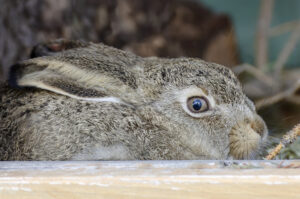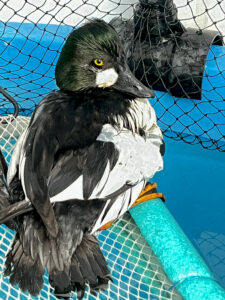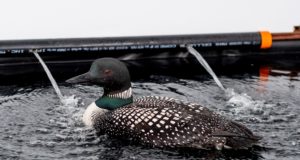For a few weeks every summer, ducks, geese and swans won’t be seen flying. This makes sense if they’re trying to protect young, but occasionally a lone bird will be found wandering and grounded. For animals that are known to make long migrations and are a common sight in the sky, this can look unusual. But it’s due to a normal process called simultaneous moulting. It occurs between May and July when waterfowl shed and regrow their feathers, including those needed for flight.
Why do birds moult?
To understand moulting, it helps to know why birds replace their feathers. There are different reasons for different species, but all birds experience their first moult when chicks develop juvenal plumage, which looks like regular feathers but may have different patterns than adult feathers.1 They can end up looking a bit funny as fluffy down pokes out among new, sleek feathers, but it doesn’t pose any danger to them.2 Once all the baby down is gone, some birds retain this plumage for just a few weeks, while others take years to develop adult colours.3
Feathers wear out throughout a bird’s lifespan, which leads to the second reason to moult. For some species, this complete moult is a relatively quick process.4 Others take several months or even years.5 Since moulting includes their flight feathers, birds that rely on being airborne to find food and avoid predators, gradually lose and regrow these one at a time, and are called sequential moulters.6 This ensures that the loss of feathers doesn’t disrupt normal behaviour.
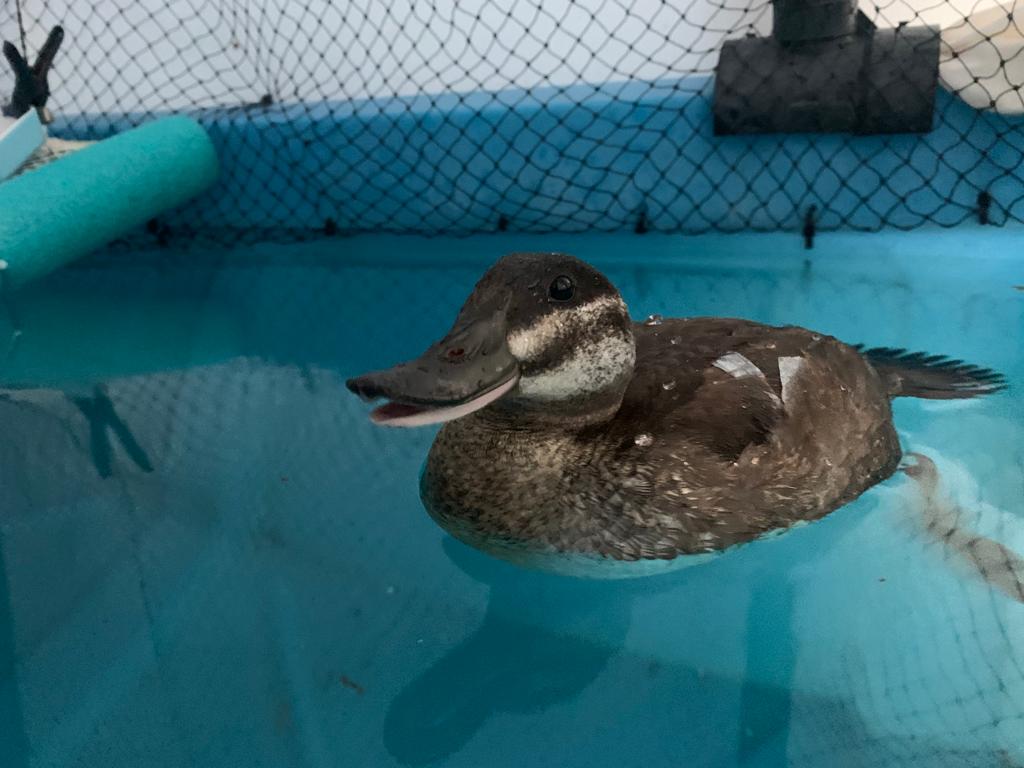
For waterfowl, the complete moult is different. Since they can forage and evade predators on the ground or in water, they lose all their flight feathers at once, which is called simultaneous moulting.7
Certain birds undergo another type of moult twice a year when they reach breeding age. Called a partial moult, it allows them to take on different appearances throughout the year.8 Many species have a specific breeding plumage that is bold and colourful, especially in males.9 It helps attract mates by demonstrating physical health. Outside of breeding times, the same birds take on a duller appearance to better blend into their environments.10 This is particularly noticeable in ducks –; their first partial moult of the year coincides with the period of flightlessness.11
Simultaneous Moulters
By the time eggs are hatching in mid-May, waterfowl have begun to shed their feathers. It’s an ideal time for it, as many adult birds must stay close to flightless offspring anyways.12 Developing a new set of feathers takes energy, so having it occur when food is abundant in the form of grasses, duckweed, aquatic insects and minnows is beneficial.13
Simultaneous moulters have adaptations to help them survive this process. Duck drakes undergo this moult at the same time that they exchange flashy body feathers for the grays and browns of eclipse plumage.14 Just as with hens and ducklings, these muted colours help them camouflage along grassy banks and in shaded ponds.15 In addition, many drakes make their way to wetlands in Canada’s boreal forest or Arctic regions.16 Here, they prepare for the second partial moult in later summer, which restores their breeding plumage.17 Hens and ducklings remain at breeding ponds where there is less competition for food. 18
In geese and swans, breeding pairs stay together and retain their feather patterns.19 Although this can make them stand out in their surroundings, physical size and defensive behaviour help keep threats away, even on land.20
By summer’s end, both adults and young of all species have developed a fresh set of flight feathers ahead of the southward migration.21
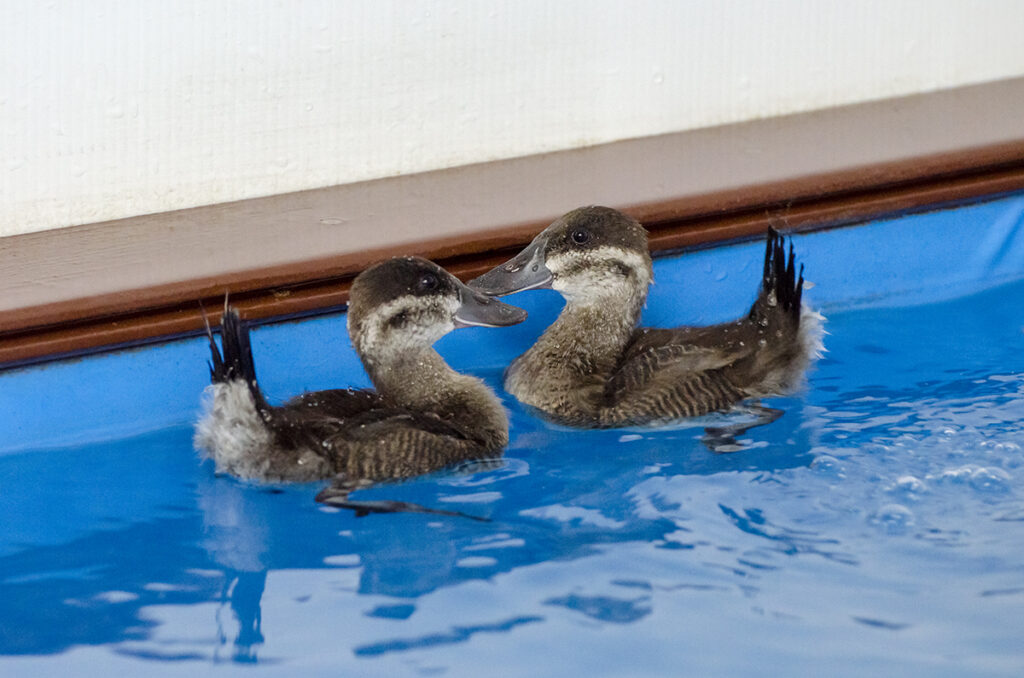
What can I do?
Conflicts can arise when waterfowl encounter people. Canada geese and mallard ducks are especially common in urban areas, where they might spread out across bike paths and wander onto front lawns.22 During encounters, the best thing to do is to give them space, or if that is impossible, proceed slowly so they have time to get out of the way.
Occasionally, these birds can be found far from their usual habitat while flightless. It’s quite a feat for one to get into a neighbourhood or downtown core without swimming or flying, but it does happen. Reasons they might travel this distance on foot is to find backyard ponds and fountains or food, like seeds scattered from bird feeders.23 Both ducks and geese have even been known to nest nearly 2 kilometres from water, so they may also have eggs nearby.24 If they get really stuck, such as in an area completely enclosed by fencing, a call to AIWC’s hotline could be necessary.25 Otherwise, giving them time and space is often all that’s needed for them to find food, avoid threats and successfully complete the moulting process.
Footnotes
- Dunn, Jon L., Alderfer, J., eds. Field Guide to the Birds of Western North America. Washington, DC: National Geographic Society, 2008.
- Luther, Erin. Answering the Call of the Wild: A Hotline Operators Guide to Helping People and Wildlife. Toronto: Toronto Wildlife Centre, 2010.
- Dunn, Jon L., Alderfer, J., eds. Field Guide to the Birds of Western North America.
- Dunn, Jon L., Alderfer, J., eds. Field Guide to the Birds of Western North America.
- Jaramillo, Alvaro. 2017. “Understanding the Basics of Bird Molts.” Accessed Feb 14, 2023. https://www.audubon.org/news/understanding-basics-bird-molts.
- Jaramillo, Alvaro., 2017. “Understanding the Basics of Bird Molts.”
- Ouimet, Elizabeth. “Feather Weather: Shedding Light on Waterfowl Moulting Season.” Conservator, Spring, 2022.
- Dunn, Jon L., Alderfer, J., eds. Field Guide to the Birds of Western North America.
- Dunn, Jon L., Alderfer, J., eds. Field Guide to the Birds of Western North America.
- Dunn, Jon L., Alderfer, J., eds. Field Guide to the Birds of Western North America.
- Ouimet, Elizabeth. “Feather Weather: Shedding Light on Waterfowl Moulting Season.”
- Gooders, John. Birds of Canada. Surrey: Dragon’s World Ltd, 1984.
- Jaramillo, Alvaro., 2017. “Understanding the Basics of Bird Molts.”
- Ouimet, Elizabeth. “Feather Weather: Shedding Light on Waterfowl Moulting Season.”
- Gooders, John. Birds of Canada. Surrey: Dragon’s World Ltd, 1984.
- Baschuk, Mark and Slattery, Stuart. n.d. “Understanding Waterfowl: The Amazing Molt.” Accessed Feb 14, 2023.
- Baschuk, Mark and Slattery, Stuart. n.d. “Understanding Waterfowl: The Amazing Molt.”
- Baschuk, Mark and Slattery, Stuart. n.d. “Understanding Waterfowl: The Amazing Molt.”
- Gooders, John. Birds of Canada. Surrey: Dragon’s World Ltd, 1984.
- Gooders, John. Birds of Canada. Surrey: Dragon’s World Ltd, 1984.
- Ouimet, Elizabeth. “Feather Weather: Shedding Light on Waterfowl Moulting Season.”
- Luther, Erin. Answering the Call of the Wild: A Hotline Operators Guide to Helping People and Wildlife.
- Luther, Erin. Answering the Call of the Wild: A Hotline Operators Guide to Helping People and Wildlife.
- Gooders, John. Birds of Canada. Surrey: Dragon’s World Ltd, 1984.
- Luther, Erin. Answering the Call of the Wild: A Hotline Operators Guide to Helping People and Wildlife.

